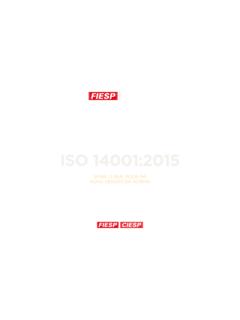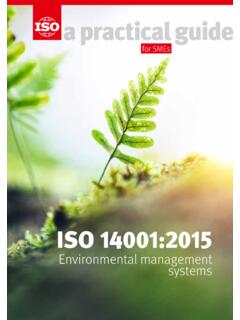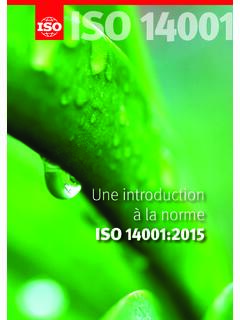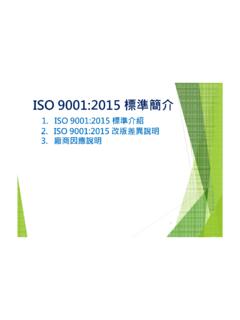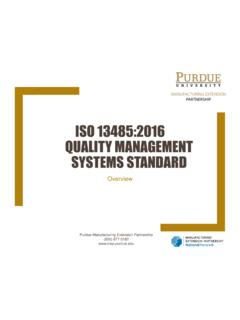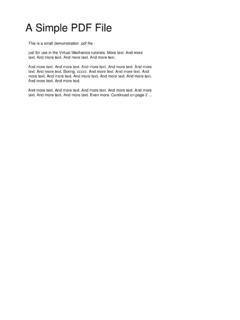Transcription of ISO 14001:2015 ENVIRONMENTAL MANAGEMENT SYSTEMS …
1 ISO 14001:2015 . ENVIRONMENTAL MANAGEMENT . SYSTEMS REQUIREMENTS. Guidance Document Introduction How we can help This DNV GL guidance document aims to give a basic overview We are here to support you during the transition, through;. of the changes to ISO 14001 , resulting from the review and direct contact, with your lead auditor as part of revision of the 2004 standard. It is not intended to give an scheduled audits exhaustive and in-depth explanation of all requirements in the new standard. open webinars and transition training classroom transition training courses, tailored to your needs ISO standards are reviewed and revised on a regular cycle, typically gap analysis, either as a separate activity or combined with every 5-10 years, and 2015 sees ISO 14001 :2004 reaching the scheduled audit activity end of that review process.
2 A draft international standard (DIS) was published, and after extensive review the final draft international combination of training and gap analysis standard (FDIS) was published in July. The ISO 14001:2015 Questions on the ISO 9001: 2015 and ISO 14001:2015 . standard was published in September 2015 . revisions LinkedIn discussion group The ISO organization has developed a common Higher Level Structure (HLS) for MANAGEMENT system standards, issued under an ISO Directive;. That directive has a series of annexes, of which we are interested in Annex SL Proposals for MANAGEMENT SYSTEMS standards.
3 This annex states that all MANAGEMENT system standards will use a consistent structure, common text and terminology, and this is enacted through Appendix 2 High level structure, identical core text, common terms and core definitions . Some revised and new standards have already implemented this requirement for example ISO 27001:2013 Information Security MANAGEMENT SYSTEMS (revised) and ISO 55001:2014. Asset MANAGEMENT Standard (new). ISO 14001 has therefore been revised in accordance with the new HLS, but it also contains additional content.
4 A whole range of country-level committees feed into the overall ISO committees which meet to decide on the revisions. The committee for ISO 14001 is TC 207. If you are a member of IEMA, or a trade federation, you can access the latest version(s). of the draft Standard(s) and even comment on the content. After the new standards are published, there will be a transition period for fully complying with them. This period will be 3 years, but it is strongly recommended that you start thinking now about how it will impact you, and review what changes might be needed.
5 Page 1 DNV GL AS, NO-1322 H vik, Norway, Tel: +47 67 57 99 00, Version Layout of ISO 14001:2015 . 1 Scope 2 Normative References 3 Terms and definitions 4 Context of the organization Understanding the organization and its context Understanding the needs and expectations of interested parties Determining the scope of the quality MANAGEMENT system ENVIRONMENTAL MANAGEMENT system 5 Leadership Leadership and commitment ENVIRONMENTAL policy Organizational roles, responsibilities and authorities 6 Planning Actions to address risks and opportunities ENVIRONMENTAL objectives and planning to achieve them 7 Support Resources Competence Awareness Communication Documented information 8 Operation Operational planning and control Emergency preparedness and response 9 Performance evaluation Monitoring, measurement, analysis and evaluation Internal audit MANAGEMENT review 10 Improvement General Nonconformity and corrective action Continual improvement Page 2 DNV GL AS, NO-1322 H vik.
6 Norway, Tel: +47 67 57 99 00, Version Understanding the organization 1. Scope and its context This section explains the scope of the standard what it is . This clause requires the organization to consider a wide for and what it encompasses. It introduces the requirements range of potential factors which can impact on the of an ENVIRONMENTAL MANAGEMENT system which supports the MANAGEMENT system, in terms of its structure, scope, fundamental ENVIRONMENTAL pillar' of sustainability, together with implementation and operation.
7 The key intended outcomes of a MANAGEMENT system including: The areas for consideration quoted in the Annex A. n enhancement of performance; guidance of the standard are wide-ranging, including;. n conforming to compliance obligations;. n fulfilment of objectives a) ENVIRONMENTAL conditions related to climate, air quality, water quality, land use, existing contamination, natural This section also makes clear that any organization claiming resource availability and biodiversity, that can either compliance with the revised standard should have incorporated affect the organization's purpose, or be affected by its all requirements of the standard within their ENVIRONMENTAL ENVIRONMENTAL aspects.
8 MANAGEMENT system. b) the external cultural, social, political, legal, regulatory, financial, technological, economic, natural and 2. Normative references competitive circumstances, whether international, national, regional or local;. As with ISO 14001 :2004 there are no normative references associated with ISO 14001:2015 . The clause is included simply c) the internal characteristics or conditions of the in order to maintain consistent alignment with the ISO High organization, such as its activities, products and services, Level Structure (HLS).
9 Strategic direction, culture and capabilities ( people, knowledge, processes, SYSTEMS ). 3. Terms and definitions Understanding the needs and expectations of interested parties This clause lists the terms and definitions that apply to the standard these are referenced where necessary back to . Clause requires the organization to determine the other ISO 14001 standards ( ISO 14031:2013). The need and expectations of interested parties , both ISO 14001:2015 standard extends the list of terms and internal and external. Previous versions of the draft definitions from the ISO 14001 :2004 standard, combining the standard also contained the term stakeholder , which mandated HLS terms and definitions together with the more many organizations will be more familiar with the terms specific terms and definitions associated with ENVIRONMENTAL are synonymous and there is no need to consider them to MANAGEMENT SYSTEMS .
10 Be any different. Interested parties could include;. n Employees 4. Context of the n Contractors Clients/Customers organization n n Suppliers n Regulators This clause sets out the requirements for an organization to n Shareholders take a high level overview of the business, considering the key n Neighbours internal and external factors which impact it, and how it should n Non-Governmental Organizations (NGOs). respond in the form of a defined MANAGEMENT system. n Parent organizations What is clear is that whilst the consideration of context and interested parties needs to be relevant to the scope and the standard, the assessment needs to be appropriate and proportionate.



